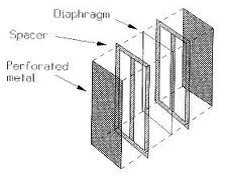It’s the time of year for saving money!
In my article, “What Gets You More? Another $10,000 Spent On The System Or A Few Bucks And Some Time Spent On Your Room?”, I wrote about some things that could be done to your listening room to improve the sound of your System without actually changing or spending any more for your speakers and other components. That was good information, and judging from their comments, most readers and even most professionals agreed and found it valuable. On further thought, though, it occurred to me that there was one basic assumption that I had made in the article and didn’t disclose, and that that assumption didn’t necessarily apply to all rooms and all Systems.
 The assumption was, of course, that both the room and the System already existed. What, though, if one or the other doesn’t exist? What if you either don’t already have the room or don’t already have the system? What if you don’t have either?
The assumption was, of course, that both the room and the System already existed. What, though, if one or the other doesn’t exist? What if you either don’t already have the room or don’t already have the system? What if you don’t have either?
Obviously, if you already have your listening room, you’re not likely to do major reconstruction or to change its basic shape or size, but what if you’re in the process of either designing or seeking to buy a new home? Then, certainly, you can either plan for ideal dimensions or seek a home with a room that already has them.
And what are those ideal dimensions? Well, George Cardas has for a long time been pursuing the “Golden Ratio” (1: approx. 1.618) for any number of things, including room dimensions. Others have suggested room dimensions based on prime numbers. The University of Salford (Manchester, UK) [http://www.acoustics.salford.ac.uk/acoustics_info/room_sizing/?content=index] said, in an article discussing a June, 2004 paper published by the AES (Audio Engineering Society) that “These ‘golden ratios’… are not necessarily the best dimensions to choose for a room…” and went on to suggest about twenty ratios of its own, all clustered around 1:2.19:3 for a range of room volumes from 50 – 200 cubic meters (about 1,760 to 7,000 cubic feet).
 With no knowledge of your particular needs, tastes, budget, or circumstances, I can’t even attempt to advise you on what the ideal room size or proportions for you might be, but I do know that you DON’T want your room to be anything like square or cubical. Rooms that are too close to regular in their dimensions will produce all kinds of problems of reflection, pressure modes, excessively long decay-rates, and uneven frequency response, and can, at best, be extremely difficult to set up. Other guaranteed “problem rooms” are those that are asymmetrical or set up asymmetrically, particularly if their asymmetry results in different right and left channel “first bounce” distances. (How to find the “first bounce” points in your room was described in the earlier article mentioned above.) “First bounce” differences will almost certainly affect your system’s imaging and soundstaging, and can cause serious frequency response anomalies, particularly in the bass and mid-bass.
With no knowledge of your particular needs, tastes, budget, or circumstances, I can’t even attempt to advise you on what the ideal room size or proportions for you might be, but I do know that you DON’T want your room to be anything like square or cubical. Rooms that are too close to regular in their dimensions will produce all kinds of problems of reflection, pressure modes, excessively long decay-rates, and uneven frequency response, and can, at best, be extremely difficult to set up. Other guaranteed “problem rooms” are those that are asymmetrical or set up asymmetrically, particularly if their asymmetry results in different right and left channel “first bounce” distances. (How to find the “first bounce” points in your room was described in the earlier article mentioned above.) “First bounce” differences will almost certainly affect your system’s imaging and soundstaging, and can cause serious frequency response anomalies, particularly in the bass and mid-bass.
A general rule-of-thumb is that a good listening room should be obviously-but-not-excessively rectangular – with a length-to-width ratio somewhere in the (broadly-defined) range of about 1.5 to 1. While ceiling height can certainly be a factor, it tends to be less controllable than the other dimensions, and therefore less necessary to take into consideration.
Whatever your room size, if you already have your speakers, you’re going to need to properly place them to get the best possible sound, and if you don’t already have them, your room size and shape is definitely something that you should consider when making your speaker purchase.
 Either way, unless you’re going to be using corner horns (like the Klipschorns, their modern emulators, or the Lansing Hartsfields or Electro-Voice Patricians) or speakers like some of the earlier models from Boston Acoustics that were designed specifically to be placed flush against the back wall, you’re going – if the best possible imaging and soundstaging is important to you – to want to place your speakers away from the wall, at least a few feet out into the room.
Either way, unless you’re going to be using corner horns (like the Klipschorns, their modern emulators, or the Lansing Hartsfields or Electro-Voice Patricians) or speakers like some of the earlier models from Boston Acoustics that were designed specifically to be placed flush against the back wall, you’re going – if the best possible imaging and soundstaging is important to you – to want to place your speakers away from the wall, at least a few feet out into the room.
Doing that, however, is going to require that you first make a decision as to which wall you want to keep them away from. Obviously, the placement of doorways, pass-throughs, and windows is going to affect how – both in terms of your furniture and your System — you can lay-out your room, but so will the dimensions, themselves. If, for example you intend to place your speakers along (and away from) one of the long walls, the “short” dimension of your room is going to become important: With your speakers a sufficient distance out into the room for the best sound, will there still be enough distance left in the short dimension for you to place your sofa or other seating far enough away from both the speakers and the other long wall to allow for both good imaging and full room access to people just passing through?
 If not, or if you’re using or planning to buy speakers like wide-format planars (electrostatics and planar magnetics), which are usually more-or-less bi-directional, and potentially “beamy”, you should probably consider placing your system along (and with the speakers away from) one of your room’s “short” walls. That’s more likely to give you the spacing you need, and planars (perhaps because of the sort of “first bounce” timing that such an arrangement provides) seem to like “short wall” placement better, anyway.
If not, or if you’re using or planning to buy speakers like wide-format planars (electrostatics and planar magnetics), which are usually more-or-less bi-directional, and potentially “beamy”, you should probably consider placing your system along (and with the speakers away from) one of your room’s “short” walls. That’s more likely to give you the spacing you need, and planars (perhaps because of the sort of “first bounce” timing that such an arrangement provides) seem to like “short wall” placement better, anyway.
Not having so much to do with shape or placement, but simply with total room volume, having your speakers and your room be a suitable match for each other is also an important consideration. I’m not sure which is worse; a pair of tiny mini-monitors in a huge room, or a pair of behemoths like the Goldmund Apologues, the Duntech Sovereigns, or the JM Labs Grande Utopias in a diminutive space, but neither is likely to be either practical or satisfying.
Just as your System and furnishings are parts of your listening room, so also is your room a vital part of your System. Setting everything up properly and making sure that your room, your speakers, and the placement of everything all work together will help you to get all of the performance of which your System is capable and all of the musical pleasure you set out to enjoy.
Go for it!





